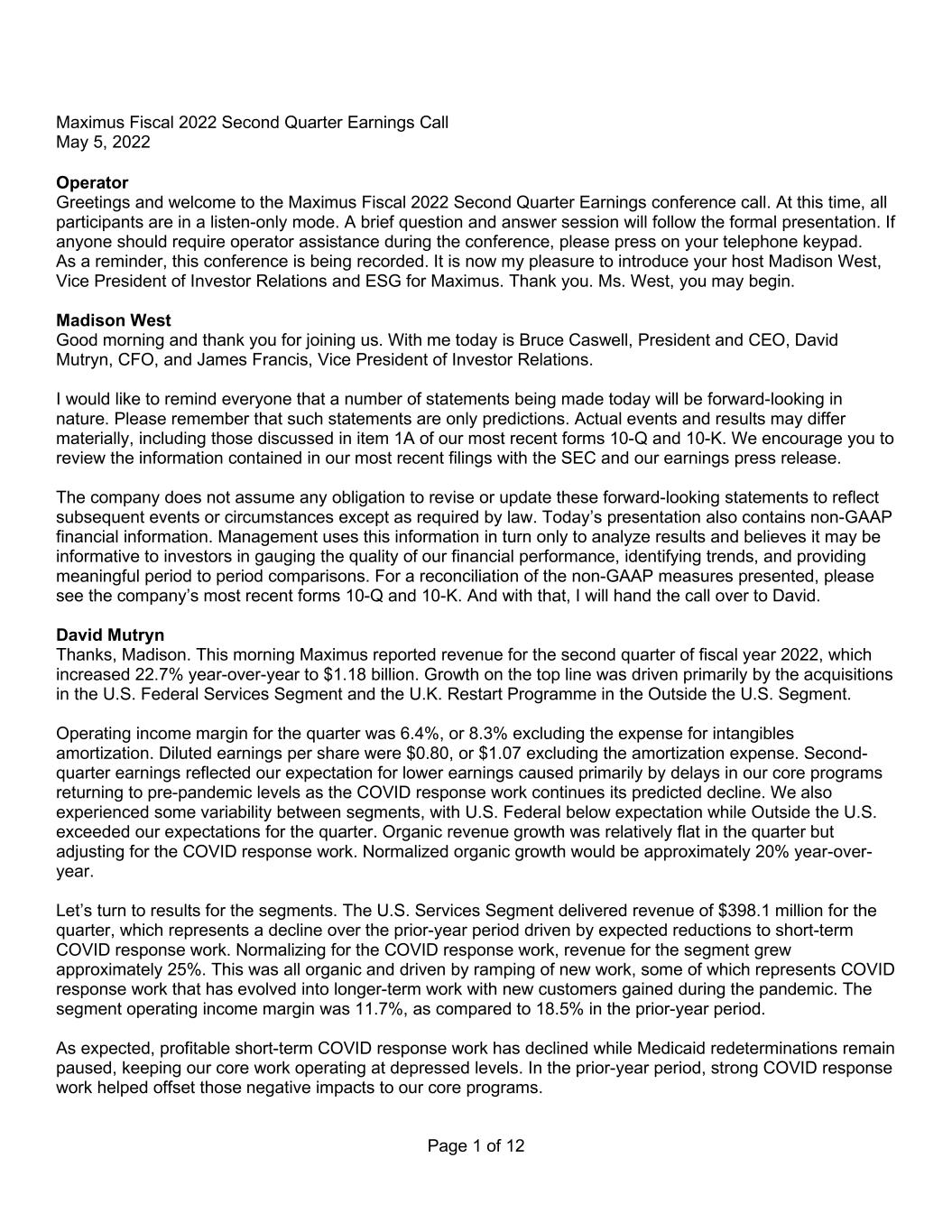
Maximus Fiscal 2022 Second Quarter Earnings Call May 5, 2022 Page 1 of 12 Operator Greetings and welcome to the Maximus Fiscal 2022 Second Quarter Earnings conference call. At this time, all participants are in a listen-only mode. A brief question and answer session will follow the formal presentation. If anyone should require operator assistance during the conference, please press on your telephone keypad. As a reminder, this conference is being recorded. It is now my pleasure to introduce your host Madison West, Vice President of Investor Relations and ESG for Maximus. Thank you. Ms. West, you may begin. Madison West Good morning and thank you for joining us. With me today is Bruce Caswell, President and CEO, David Mutryn, CFO, and James Francis, Vice President of Investor Relations. I would like to remind everyone that a number of statements being made today will be forward-looking in nature. Please remember that such statements are only predictions. Actual events and results may differ materially, including those discussed in item 1A of our most recent forms 10-Q and 10-K. We encourage you to review the information contained in our most recent filings with the SEC and our earnings press release. The company does not assume any obligation to revise or update these forward-looking statements to reflect subsequent events or circumstances except as required by law. Today’s presentation also contains non-GAAP financial information. Management uses this information in turn only to analyze results and believes it may be informative to investors in gauging the quality of our financial performance, identifying trends, and providing meaningful period to period comparisons. For a reconciliation of the non-GAAP measures presented, please see the company’s most recent forms 10-Q and 10-K. And with that, I will hand the call over to David. David Mutryn Thanks, Madison. This morning Maximus reported revenue for the second quarter of fiscal year 2022, which increased 22.7% year-over-year to $1.18 billion. Growth on the top line was driven primarily by the acquisitions in the U.S. Federal Services Segment and the U.K. Restart Programme in the Outside the U.S. Segment. Operating income margin for the quarter was 6.4%, or 8.3% excluding the expense for intangibles amortization. Diluted earnings per share were $0.80, or $1.07 excluding the amortization expense. Second- quarter earnings reflected our expectation for lower earnings caused primarily by delays in our core programs returning to pre-pandemic levels as the COVID response work continues its predicted decline. We also experienced some variability between segments, with U.S. Federal below expectation while Outside the U.S. exceeded our expectations for the quarter. Organic revenue growth was relatively flat in the quarter but adjusting for the COVID response work. Normalized organic growth would be approximately 20% year-over- year. Let’s turn to results for the segments. The U.S. Services Segment delivered revenue of $398.1 million for the quarter, which represents a decline over the prior-year period driven by expected reductions to short-term COVID response work. Normalizing for the COVID response work, revenue for the segment grew approximately 25%. This was all organic and driven by ramping of new work, some of which represents COVID response work that has evolved into longer-term work with new customers gained during the pandemic. The segment operating income margin was 11.7%, as compared to 18.5% in the prior-year period. As expected, profitable short-term COVID response work has declined while Medicaid redeterminations remain paused, keeping our core work operating at depressed levels. In the prior-year period, strong COVID response work helped offset those negative impacts to our core programs.
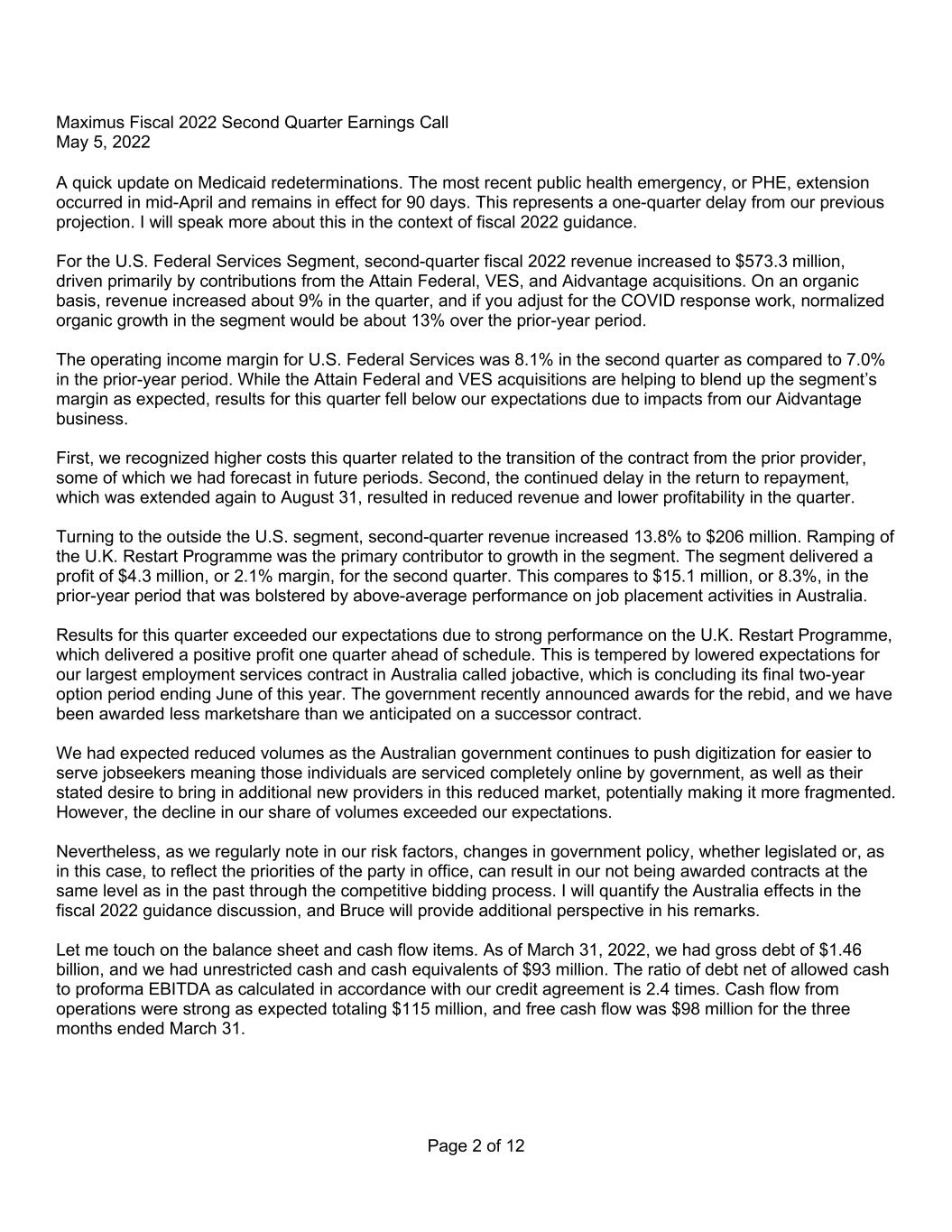
Maximus Fiscal 2022 Second Quarter Earnings Call May 5, 2022 Page 2 of 12 A quick update on Medicaid redeterminations. The most recent public health emergency, or PHE, extension occurred in mid-April and remains in effect for 90 days. This represents a one-quarter delay from our previous projection. I will speak more about this in the context of fiscal 2022 guidance. For the U.S. Federal Services Segment, second-quarter fiscal 2022 revenue increased to $573.3 million, driven primarily by contributions from the Attain Federal, VES, and Aidvantage acquisitions. On an organic basis, revenue increased about 9% in the quarter, and if you adjust for the COVID response work, normalized organic growth in the segment would be about 13% over the prior-year period. The operating income margin for U.S. Federal Services was 8.1% in the second quarter as compared to 7.0% in the prior-year period. While the Attain Federal and VES acquisitions are helping to blend up the segment’s margin as expected, results for this quarter fell below our expectations due to impacts from our Aidvantage business. First, we recognized higher costs this quarter related to the transition of the contract from the prior provider, some of which we had forecast in future periods. Second, the continued delay in the return to repayment, which was extended again to August 31, resulted in reduced revenue and lower profitability in the quarter. Turning to the outside the U.S. segment, second-quarter revenue increased 13.8% to $206 million. Ramping of the U.K. Restart Programme was the primary contributor to growth in the segment. The segment delivered a profit of $4.3 million, or 2.1% margin, for the second quarter. This compares to $15.1 million, or 8.3%, in the prior-year period that was bolstered by above-average performance on job placement activities in Australia. Results for this quarter exceeded our expectations due to strong performance on the U.K. Restart Programme, which delivered a positive profit one quarter ahead of schedule. This is tempered by lowered expectations for our largest employment services contract in Australia called jobactive, which is concluding its final two-year option period ending June of this year. The government recently announced awards for the rebid, and we have been awarded less marketshare than we anticipated on a successor contract. We had expected reduced volumes as the Australian government continues to push digitization for easier to serve jobseekers meaning those individuals are serviced completely online by government, as well as their stated desire to bring in additional new providers in this reduced market, potentially making it more fragmented. However, the decline in our share of volumes exceeded our expectations. Nevertheless, as we regularly note in our risk factors, changes in government policy, whether legislated or, as in this case, to reflect the priorities of the party in office, can result in our not being awarded contracts at the same level as in the past through the competitive bidding process. I will quantify the Australia effects in the fiscal 2022 guidance discussion, and Bruce will provide additional perspective in his remarks. Let me touch on the balance sheet and cash flow items. As of March 31, 2022, we had gross debt of $1.46 billion, and we had unrestricted cash and cash equivalents of $93 million. The ratio of debt net of allowed cash to proforma EBITDA as calculated in accordance with our credit agreement is 2.4 times. Cash flow from operations were strong as expected totaling $115 million, and free cash flow was $98 million for the three months ended March 31.

Maximus Fiscal 2022 Second Quarter Earnings Call May 5, 2022 Page 3 of 12 We repurchased approximately 330,000 shares totaling $24 million in the second quarter. We had good cash collections, and our DSO at March 31 was 68 days putting us at the lower end of our target range of 65 to 80 days. Now I will turn to our revised fiscal 2022 guidance. We are maintaining our revenue guidance of $4.5 billion to $4.7 billion for the full fiscal year. We now expect diluted EPS of $3.00 to $3.50, or $4.07 to $4.57 on an adjusted basis which excludes intangible amortization expense. We are deliberately providing a wider range than we normally would at this point in the year. The revised earnings guidance equates to a $1 reduction on the low end and an $0.80 reduction on the high end. The reductions are driven by three components. Number one is the PHE. I mentioned on the February earnings call that another delay to the PHE would likely risk us not making the guidance range we gave at that time. At that point, the PHE extension lasted through mid-April. Since then, another delay has occurred, meaning as of today, the PHE now lasts through mid-July. A rough order of magnitude for this one-quarter shift is a $0.30 reduction from guidance provided in February. However, given the politicized nature of the PHE and midterm election considerations, we felt it prudent to accommodate in our guidance the potential for an additional extension or extensions beyond mid-July, meaning redeterminations would remain paused through our fiscal 2022. The estimated effect of the PHE extending beyond September 30 would be a roughly $0.60 reduction from our prior guidance. Given that if you only assess the variability tied to the PHE, no additional extensions would put us in the upper half of the new guidance range, while an additional extension would put us in the lower half. While the pause in redeterminations as a result of the PHE reduces our annual forecast and more extensions push that work to the right, every indication is that the volumes will return as states work through the backlog of nearly 87 million Medicaid and CHIP enrollees as of January 2022. Number two is delays on ramping of new work in the U.S. Services and Outside the U.S. Segments, which equates to about $0.20 of the guidance reduction. The U.S. Services’ new work is driven by fiscal year 2021 awards that were scheduled to start earlier in fiscal year 2022 but have been delayed by the customer and should begin in this third quarter. The delays in Outside the U.S. are mainly in employment services contracts in other geographies besides the U.K. and Australia, where volumes have been slower to increase in part due to COVID disruptions. For both segments, we believe these delays are temporary. And number three is Australia. As I mentioned, we were disappointed with the reduction to workshare on the rebid. This has an outsized impact to fiscal year 2022 compared to subsequent periods. The new contract begins on July 1, so our fourth quarter will reflect the lower run rate. However, the accounting standards require us to recognize revenue based on anticipated future outcomes, so the lower volume means a reduction to Q3 revenue and profit as well. We also expect to incur severance charges of between $4 million and $5 million in the third quarter. In total, these changes in Australia drove a reduction of about $0.15 to our guidance for fiscal year 2022. As with most of our contracts, we have a highly variable cost structure. That means, on a go-forward basis, we expect to reduce costs, operate the new contract profitably, and ultimately have a few cents less of diluted EPS on an annual basis.
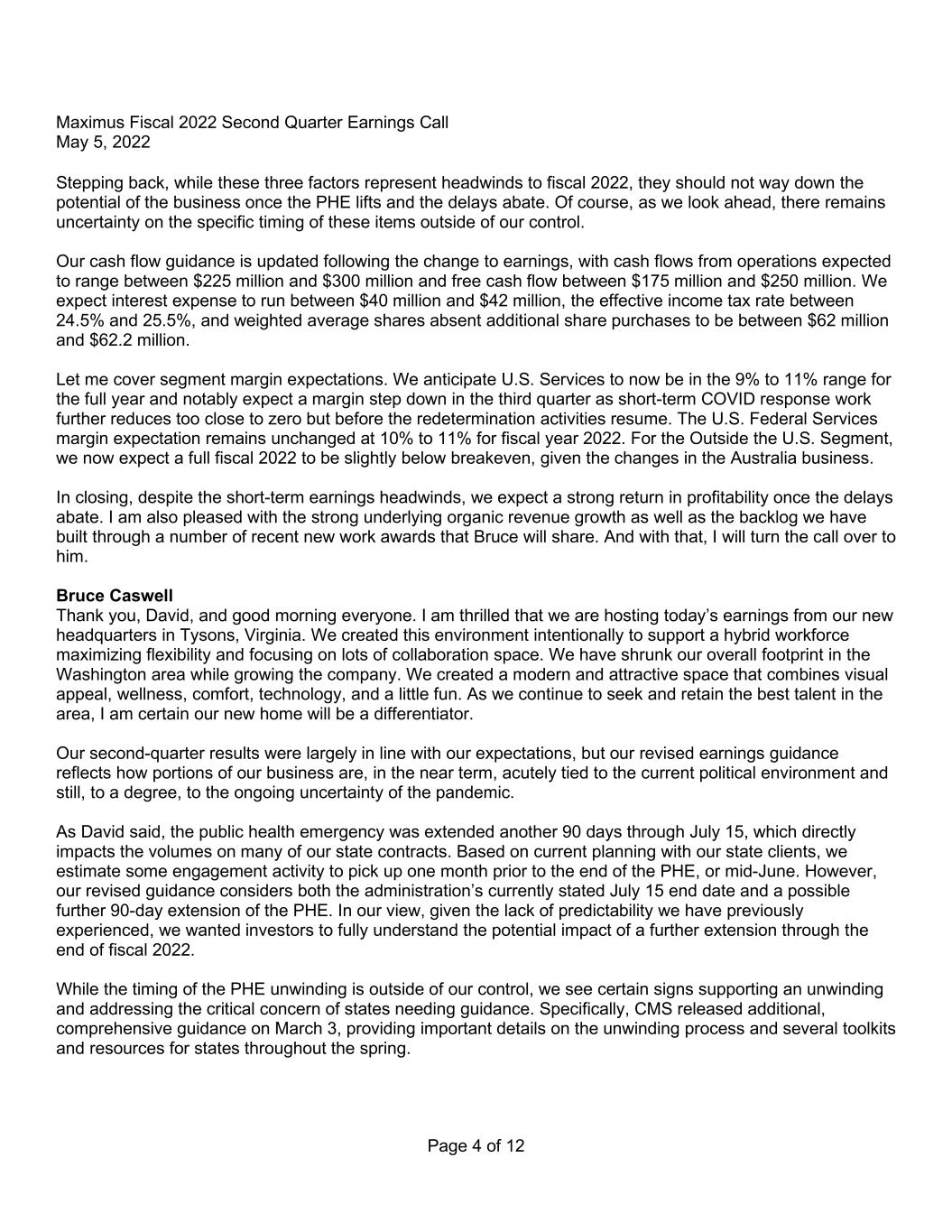
Maximus Fiscal 2022 Second Quarter Earnings Call May 5, 2022 Page 4 of 12 Stepping back, while these three factors represent headwinds to fiscal 2022, they should not way down the potential of the business once the PHE lifts and the delays abate. Of course, as we look ahead, there remains uncertainty on the specific timing of these items outside of our control. Our cash flow guidance is updated following the change to earnings, with cash flows from operations expected to range between $225 million and $300 million and free cash flow between $175 million and $250 million. We expect interest expense to run between $40 million and $42 million, the effective income tax rate between 24.5% and 25.5%, and weighted average shares absent additional share purchases to be between $62 million and $62.2 million. Let me cover segment margin expectations. We anticipate U.S. Services to now be in the 9% to 11% range for the full year and notably expect a margin step down in the third quarter as short-term COVID response work further reduces too close to zero but before the redetermination activities resume. The U.S. Federal Services margin expectation remains unchanged at 10% to 11% for fiscal year 2022. For the Outside the U.S. Segment, we now expect a full fiscal 2022 to be slightly below breakeven, given the changes in the Australia business. In closing, despite the short-term earnings headwinds, we expect a strong return in profitability once the delays abate. I am also pleased with the strong underlying organic revenue growth as well as the backlog we have built through a number of recent new work awards that Bruce will share. And with that, I will turn the call over to him. Bruce Caswell Thank you, David, and good morning everyone. I am thrilled that we are hosting today’s earnings from our new headquarters in Tysons, Virginia. We created this environment intentionally to support a hybrid workforce maximizing flexibility and focusing on lots of collaboration space. We have shrunk our overall footprint in the Washington area while growing the company. We created a modern and attractive space that combines visual appeal, wellness, comfort, technology, and a little fun. As we continue to seek and retain the best talent in the area, I am certain our new home will be a differentiator. Our second-quarter results were largely in line with our expectations, but our revised earnings guidance reflects how portions of our business are, in the near term, acutely tied to the current political environment and still, to a degree, to the ongoing uncertainty of the pandemic. As David said, the public health emergency was extended another 90 days through July 15, which directly impacts the volumes on many of our state contracts. Based on current planning with our state clients, we estimate some engagement activity to pick up one month prior to the end of the PHE, or mid-June. However, our revised guidance considers both the administration’s currently stated July 15 end date and a possible further 90-day extension of the PHE. In our view, given the lack of predictability we have previously experienced, we wanted investors to fully understand the potential impact of a further extension through the end of fiscal 2022. While the timing of the PHE unwinding is outside of our control, we see certain signs supporting an unwinding and addressing the critical concern of states needing guidance. Specifically, CMS released additional, comprehensive guidance on March 3, providing important details on the unwinding process and several toolkits and resources for states throughout the spring.
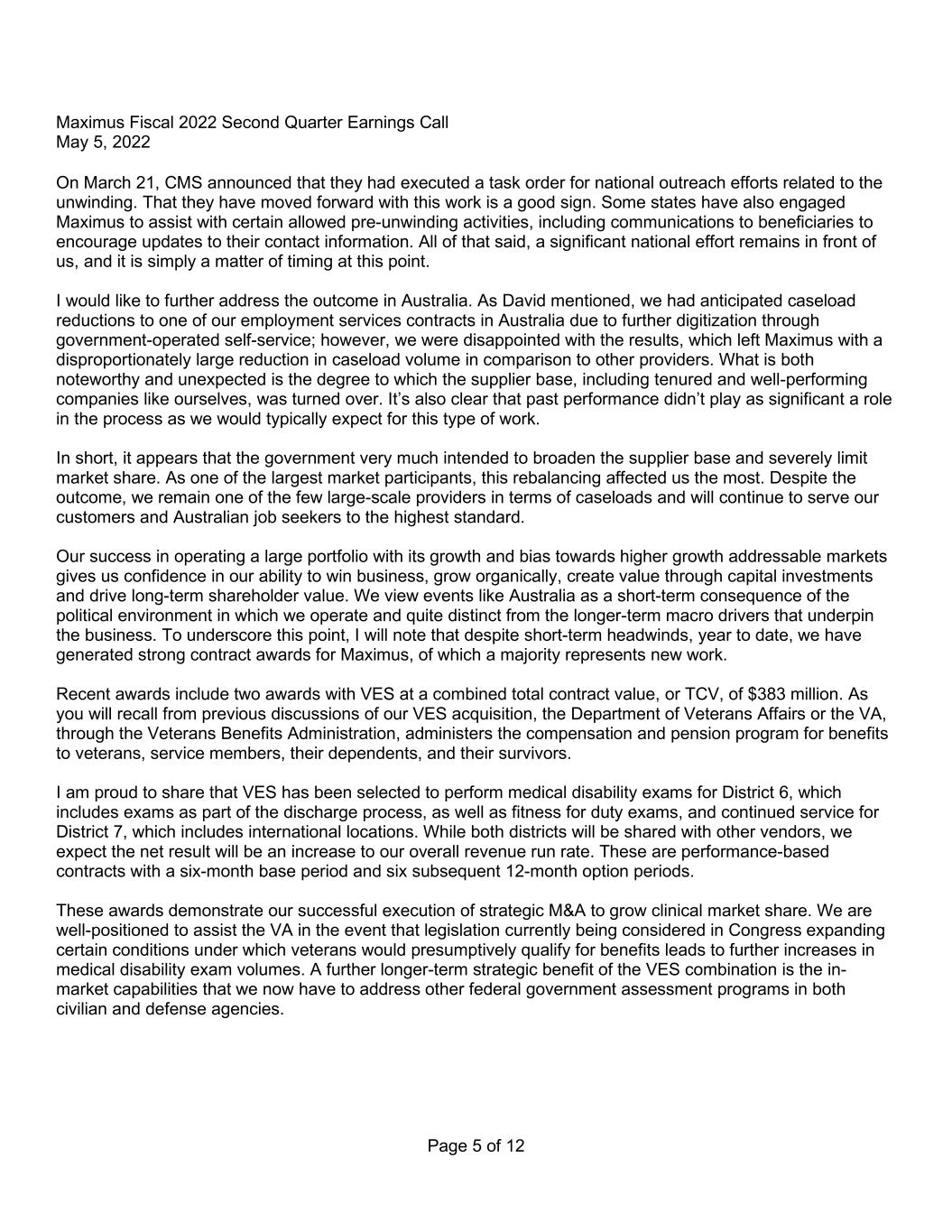
Maximus Fiscal 2022 Second Quarter Earnings Call May 5, 2022 Page 5 of 12 On March 21, CMS announced that they had executed a task order for national outreach efforts related to the unwinding. That they have moved forward with this work is a good sign. Some states have also engaged Maximus to assist with certain allowed pre-unwinding activities, including communications to beneficiaries to encourage updates to their contact information. All of that said, a significant national effort remains in front of us, and it is simply a matter of timing at this point. I would like to further address the outcome in Australia. As David mentioned, we had anticipated caseload reductions to one of our employment services contracts in Australia due to further digitization through government-operated self-service; however, we were disappointed with the results, which left Maximus with a disproportionately large reduction in caseload volume in comparison to other providers. What is both noteworthy and unexpected is the degree to which the supplier base, including tenured and well-performing companies like ourselves, was turned over. It’s also clear that past performance didn’t play as significant a role in the process as we would typically expect for this type of work. In short, it appears that the government very much intended to broaden the supplier base and severely limit market share. As one of the largest market participants, this rebalancing affected us the most. Despite the outcome, we remain one of the few large-scale providers in terms of caseloads and will continue to serve our customers and Australian job seekers to the highest standard. Our success in operating a large portfolio with its growth and bias towards higher growth addressable markets gives us confidence in our ability to win business, grow organically, create value through capital investments and drive long-term shareholder value. We view events like Australia as a short-term consequence of the political environment in which we operate and quite distinct from the longer-term macro drivers that underpin the business. To underscore this point, I will note that despite short-term headwinds, year to date, we have generated strong contract awards for Maximus, of which a majority represents new work. Recent awards include two awards with VES at a combined total contract value, or TCV, of $383 million. As you will recall from previous discussions of our VES acquisition, the Department of Veterans Affairs or the VA, through the Veterans Benefits Administration, administers the compensation and pension program for benefits to veterans, service members, their dependents, and their survivors. I am proud to share that VES has been selected to perform medical disability exams for District 6, which includes exams as part of the discharge process, as well as fitness for duty exams, and continued service for District 7, which includes international locations. While both districts will be shared with other vendors, we expect the net result will be an increase to our overall revenue run rate. These are performance-based contracts with a six-month base period and six subsequent 12-month option periods. These awards demonstrate our successful execution of strategic M&A to grow clinical market share. We are well-positioned to assist the VA in the event that legislation currently being considered in Congress expanding certain conditions under which veterans would presumptively qualify for benefits leads to further increases in medical disability exam volumes. A further longer-term strategic benefit of the VES combination is the in- market capabilities that we now have to address other federal government assessment programs in both civilian and defense agencies.
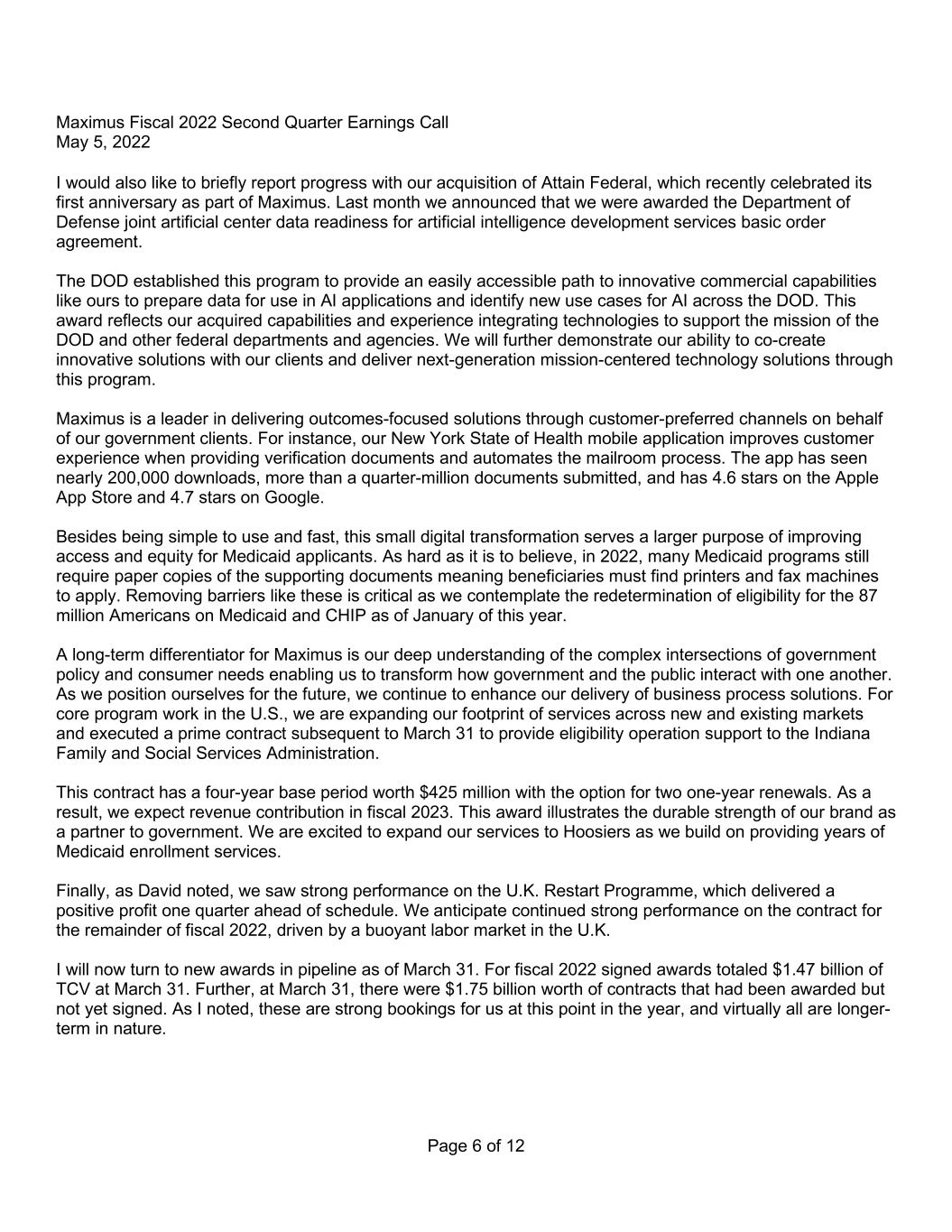
Maximus Fiscal 2022 Second Quarter Earnings Call May 5, 2022 Page 6 of 12 I would also like to briefly report progress with our acquisition of Attain Federal, which recently celebrated its first anniversary as part of Maximus. Last month we announced that we were awarded the Department of Defense joint artificial center data readiness for artificial intelligence development services basic order agreement. The DOD established this program to provide an easily accessible path to innovative commercial capabilities like ours to prepare data for use in AI applications and identify new use cases for AI across the DOD. This award reflects our acquired capabilities and experience integrating technologies to support the mission of the DOD and other federal departments and agencies. We will further demonstrate our ability to co-create innovative solutions with our clients and deliver next-generation mission-centered technology solutions through this program. Maximus is a leader in delivering outcomes-focused solutions through customer-preferred channels on behalf of our government clients. For instance, our New York State of Health mobile application improves customer experience when providing verification documents and automates the mailroom process. The app has seen nearly 200,000 downloads, more than a quarter-million documents submitted, and has 4.6 stars on the Apple App Store and 4.7 stars on Google. Besides being simple to use and fast, this small digital transformation serves a larger purpose of improving access and equity for Medicaid applicants. As hard as it is to believe, in 2022, many Medicaid programs still require paper copies of the supporting documents meaning beneficiaries must find printers and fax machines to apply. Removing barriers like these is critical as we contemplate the redetermination of eligibility for the 87 million Americans on Medicaid and CHIP as of January of this year. A long-term differentiator for Maximus is our deep understanding of the complex intersections of government policy and consumer needs enabling us to transform how government and the public interact with one another. As we position ourselves for the future, we continue to enhance our delivery of business process solutions. For core program work in the U.S., we are expanding our footprint of services across new and existing markets and executed a prime contract subsequent to March 31 to provide eligibility operation support to the Indiana Family and Social Services Administration. This contract has a four-year base period worth $425 million with the option for two one-year renewals. As a result, we expect revenue contribution in fiscal 2023. This award illustrates the durable strength of our brand as a partner to government. We are excited to expand our services to Hoosiers as we build on providing years of Medicaid enrollment services. Finally, as David noted, we saw strong performance on the U.K. Restart Programme, which delivered a positive profit one quarter ahead of schedule. We anticipate continued strong performance on the contract for the remainder of fiscal 2022, driven by a buoyant labor market in the U.K. I will now turn to new awards in pipeline as of March 31. For fiscal 2022 signed awards totaled $1.47 billion of TCV at March 31. Further, at March 31, there were $1.75 billion worth of contracts that had been awarded but not yet signed. As I noted, these are strong bookings for us at this point in the year, and virtually all are longer- term in nature.
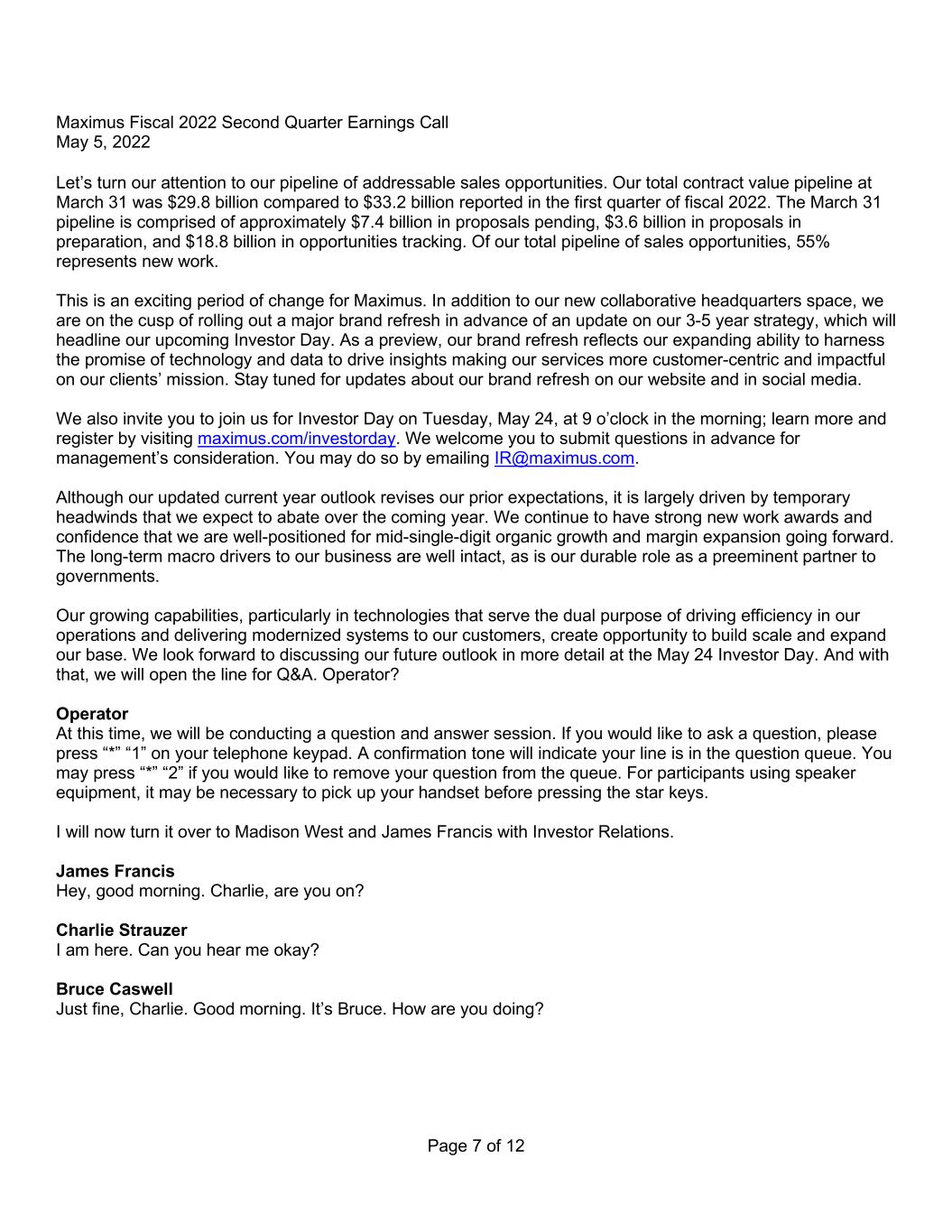
Maximus Fiscal 2022 Second Quarter Earnings Call May 5, 2022 Page 7 of 12 Let’s turn our attention to our pipeline of addressable sales opportunities. Our total contract value pipeline at March 31 was $29.8 billion compared to $33.2 billion reported in the first quarter of fiscal 2022. The March 31 pipeline is comprised of approximately $7.4 billion in proposals pending, $3.6 billion in proposals in preparation, and $18.8 billion in opportunities tracking. Of our total pipeline of sales opportunities, 55% represents new work. This is an exciting period of change for Maximus. In addition to our new collaborative headquarters space, we are on the cusp of rolling out a major brand refresh in advance of an update on our 3-5 year strategy, which will headline our upcoming Investor Day. As a preview, our brand refresh reflects our expanding ability to harness the promise of technology and data to drive insights making our services more customer-centric and impactful on our clients’ mission. Stay tuned for updates about our brand refresh on our website and in social media. We also invite you to join us for Investor Day on Tuesday, May 24, at 9 o’clock in the morning; learn more and register by visiting maximus.com/investorday. We welcome you to submit questions in advance for management’s consideration. You may do so by emailing IR@maximus.com. Although our updated current year outlook revises our prior expectations, it is largely driven by temporary headwinds that we expect to abate over the coming year. We continue to have strong new work awards and confidence that we are well-positioned for mid-single-digit organic growth and margin expansion going forward. The long-term macro drivers to our business are well intact, as is our durable role as a preeminent partner to governments. Our growing capabilities, particularly in technologies that serve the dual purpose of driving efficiency in our operations and delivering modernized systems to our customers, create opportunity to build scale and expand our base. We look forward to discussing our future outlook in more detail at the May 24 Investor Day. And with that, we will open the line for Q&A. Operator? Operator At this time, we will be conducting a question and answer session. If you would like to ask a question, please press “*” “1” on your telephone keypad. A confirmation tone will indicate your line is in the question queue. You may press “*” “2” if you would like to remove your question from the queue. For participants using speaker equipment, it may be necessary to pick up your handset before pressing the star keys. I will now turn it over to Madison West and James Francis with Investor Relations. James Francis Hey, good morning. Charlie, are you on? Charlie Strauzer I am here. Can you hear me okay? Bruce Caswell Just fine, Charlie. Good morning. It’s Bruce. How are you doing?

Maximus Fiscal 2022 Second Quarter Earnings Call May 5, 2022 Page 8 of 12 Charlie Strauzer Good morning, Bruce. How are you? Just a few questions for you this morning, if that is okay. First off, starting off with the guidance, you know, obviously maintaining revenue guidance was a little bit surprising given the magnitude of the reduction of the EPS line. Can you talk a little bit more about the factors at play there? Is it, you know, mostly mix kind of thing that we should think about? Bruce Caswell Yes, absolutely. David is going to take that one, Charlie. David Mutryn Hi, Charlie. So all three items that I called out disproportionately affect our earnings, and while they all do create some revenue impact, it’s not enough to move us out of the guidance range we gave previously, so just going through each one of them; first on the redeterminations, they happen to be very profitable on the margin since in many cases our existing staff can handle much of that volume. And then in Australia, for the next two quarters, it is really the margin that dips since we see revenue falling off faster than cost there, and the severance charge has no revenue impact. And then the last item was the new work delays. They do have a modest revenue impact but, again, not enough to move us out of the range. Charlie Strauzer Got it. Understood. Thank you very much there. And then I know we are a little bit early to talk about ’23, but if we could possibly have a little conversation about, you know, what kind of a normalized year would look like given all of the, you know, gyrations this year with the PHE getting pushed out, COVID work dropping off, and things like that maybe give us a sense for what kind of a normalized year might look like next year. David Mutryn Yes, good question. So as you know, the exact timing around the PHE unwinding remains to be seen, which makes predictions for the fiscal year ’23 itself difficult to do but let me provide some data points that I think may be helpful. So when the PHE expires and the delays abate, I would currently expect the following margin ranges, the operating income margin ranges for each segment; so for U.S. Services 11% to 14%, for U.S. Federal in the 10% to 12% range, and for Outside the U.S. 3% to 7%. So it is the midpoint of those ranges that would put the total company GAAP-aligned margin at around 9%. And then for revenue, we target sustainable mid-single-digit organic growth; our recent new work awards have been strong; however, remember we have about $300 million of short-term COVID response work that is in the fiscal year ’22 base. We are also monitoring the potential of some form of student loan forgiveness as that may have an impact on the top line. We do normally provide our formal guidance for the new fiscal year in November, and that is our current plan. James Francis Great. Anything else, Charlie?

Maximus Fiscal 2022 Second Quarter Earnings Call May 5, 2022 Page 9 of 12 Charlie Strauzer Sure. If we maybe could segue on the award side, you had a significant amount of signed awards and unsigned awards in the quarter maybe a little bit more color there, Bruce, on what type of work you have one there and also maybe an update on the rebid from the call center contract. Bruce Caswell Sure, Charlie, happy to do that. You know, it was really a very strong quarter for us in terms of signed and unsigned, and I mentioned one contract, in particular, that has signed subsequent to the quarter close, and that is our contract to provide central and regional change centers eligibility operations really for the state of Indiana. To give you a little bit more color on that, this is right in our wheelhouse. This is eligibility determination services; we are the national leader in these services. We will provide them for Medicaid and SNAP and TANF beneficiaries. Our tasks include things like that you are quite familiar with application processing, contact center operations, hearings and appeals, and so forth. We will operate ten regional change centers on behalf of the client and be co-resident in those centers with state employees, which is a model we are familiar with, and then one central change center. It is a four-year base contract worth $425 million and then two one-year renewals that are not included in that number. Moving to the next one. We spoke--I spoke a little in my prepared remarks about the awards that we were pleased to receive in the VES business, and that is District 6, which is predischarge examinations and fitness for duty examinations at military bases. That is new work for us. We have not been on the District 6 contract historically. And in District 7, which is supporting these medical disability examinations in the international arena. We think that together these will provide incremental revenue growth for that business next year, so we are thrilled that already with that combination with VES, we are seeing the benefits of organic growth, which we were hoping to see. The VA is really looking at this point to improve processing times for veterans and turnaround time on these medical disability examinations as the pandemic is abating and more veterans are being seen and so forth, so through these awards, they are building some capacity. And it is also worth noting, as I mentioned briefly in my prepared remarks, that there are additional presumptive benefits being considered on the hill right now in legislation that relates to conditions, for example, like burn pits, and you are probably familiar that the President has taken this issue on personally and traveled recently to Texas to speak on the importance of providing veterans these benefits in the future. So there’s good momentum for this legislation, and we think the VA, through its actions, is helping to prepare additional capacity for those volumes when they come into the system subsequently. I will also note that in the quarter, we were thrilled to extend a contract that we had for a customer for a number of years for another three years, so our business model is to win our rebids and to have decades-long relationships and that kind of factored into those numbers as well so overall really excellent you know organic growth long-term in nature and really core to the business as we would have hoped. Hope that helps.
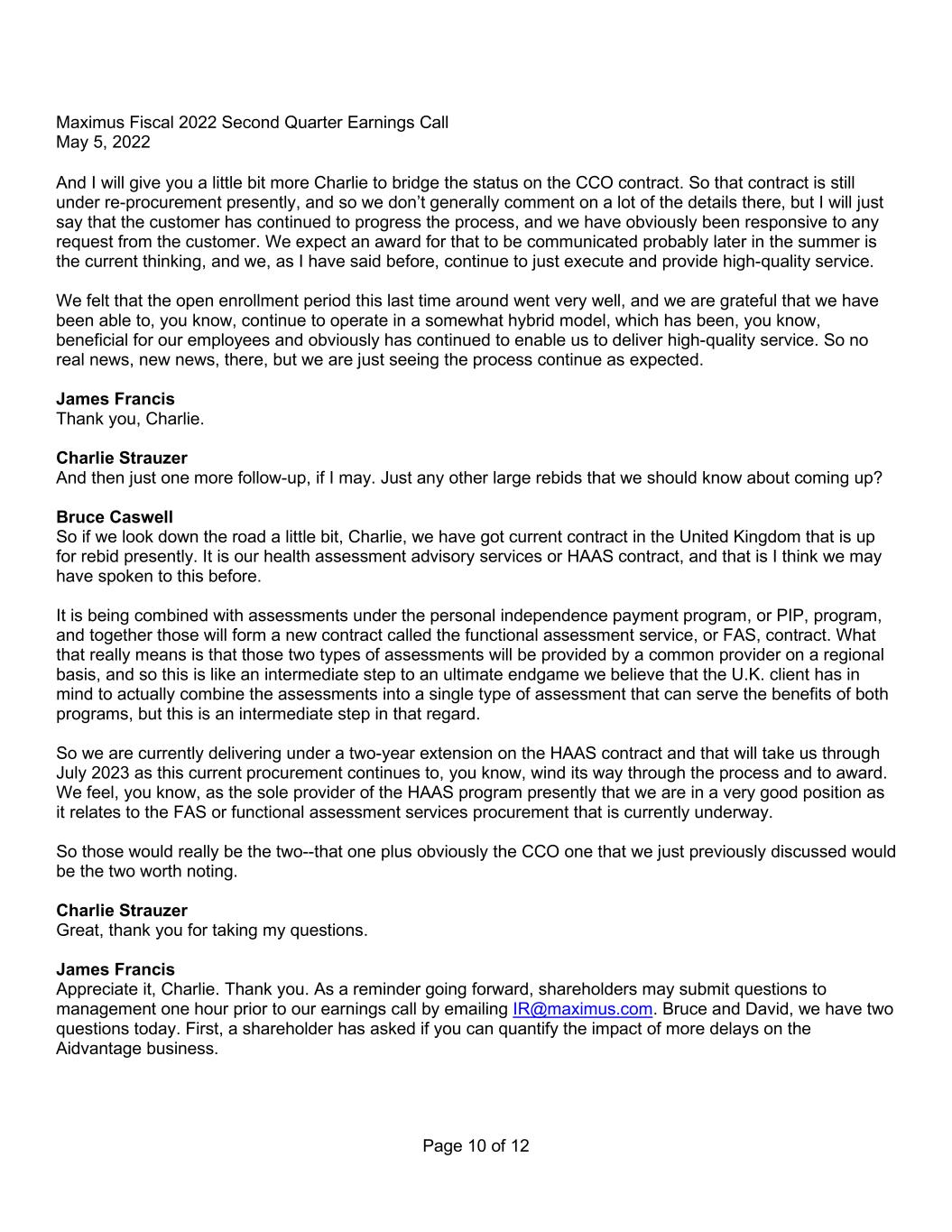
Maximus Fiscal 2022 Second Quarter Earnings Call May 5, 2022 Page 10 of 12 And I will give you a little bit more Charlie to bridge the status on the CCO contract. So that contract is still under re-procurement presently, and so we don’t generally comment on a lot of the details there, but I will just say that the customer has continued to progress the process, and we have obviously been responsive to any request from the customer. We expect an award for that to be communicated probably later in the summer is the current thinking, and we, as I have said before, continue to just execute and provide high-quality service. We felt that the open enrollment period this last time around went very well, and we are grateful that we have been able to, you know, continue to operate in a somewhat hybrid model, which has been, you know, beneficial for our employees and obviously has continued to enable us to deliver high-quality service. So no real news, new news, there, but we are just seeing the process continue as expected. James Francis Thank you, Charlie. Charlie Strauzer And then just one more follow-up, if I may. Just any other large rebids that we should know about coming up? Bruce Caswell So if we look down the road a little bit, Charlie, we have got current contract in the United Kingdom that is up for rebid presently. It is our health assessment advisory services or HAAS contract, and that is I think we may have spoken to this before. It is being combined with assessments under the personal independence payment program, or PIP, program, and together those will form a new contract called the functional assessment service, or FAS, contract. What that really means is that those two types of assessments will be provided by a common provider on a regional basis, and so this is like an intermediate step to an ultimate endgame we believe that the U.K. client has in mind to actually combine the assessments into a single type of assessment that can serve the benefits of both programs, but this is an intermediate step in that regard. So we are currently delivering under a two-year extension on the HAAS contract and that will take us through July 2023 as this current procurement continues to, you know, wind its way through the process and to award. We feel, you know, as the sole provider of the HAAS program presently that we are in a very good position as it relates to the FAS or functional assessment services procurement that is currently underway. So those would really be the two--that one plus obviously the CCO one that we just previously discussed would be the two worth noting. Charlie Strauzer Great, thank you for taking my questions. James Francis Appreciate it, Charlie. Thank you. As a reminder going forward, shareholders may submit questions to management one hour prior to our earnings call by emailing IR@maximus.com. Bruce and David, we have two questions today. First, a shareholder has asked if you can quantify the impact of more delays on the Aidvantage business.
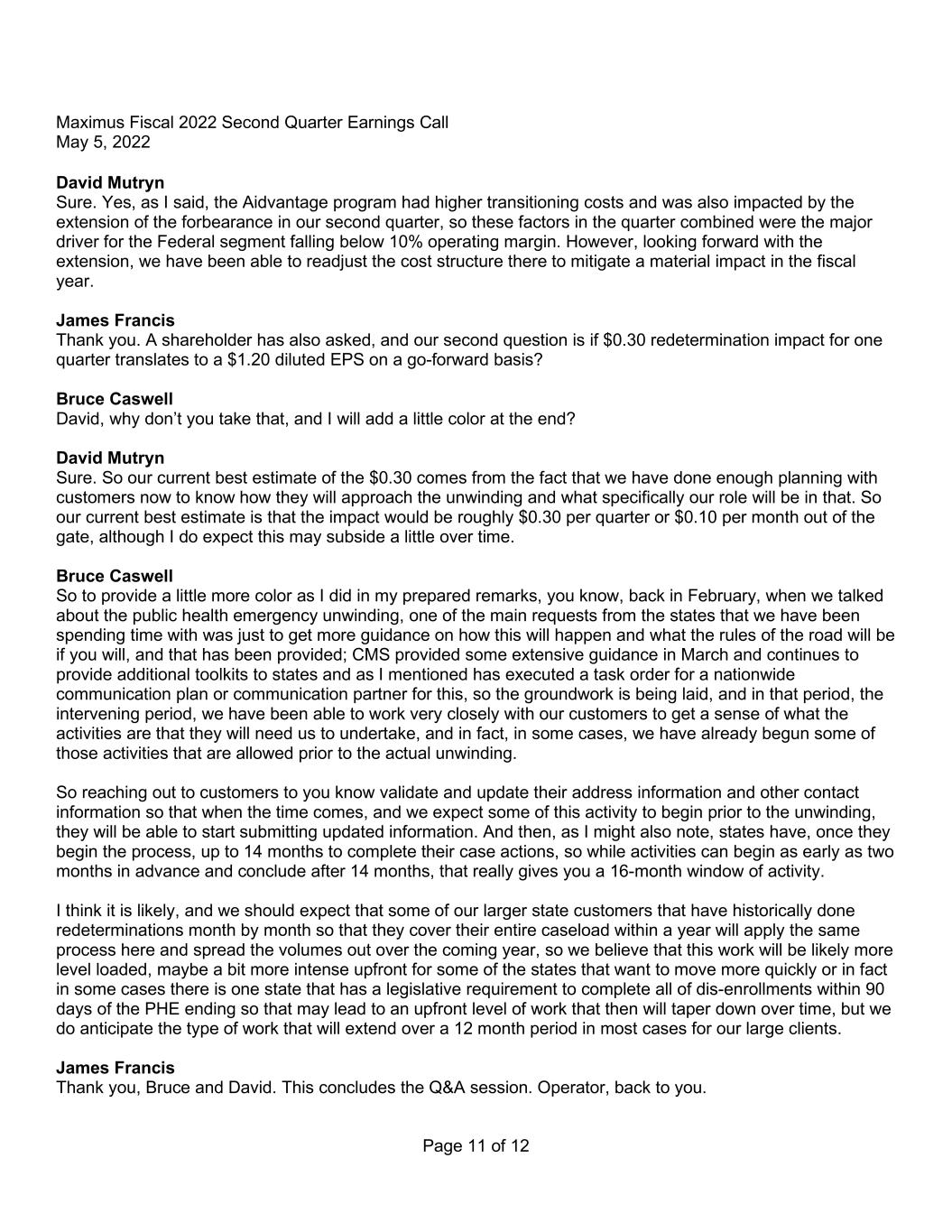
Maximus Fiscal 2022 Second Quarter Earnings Call May 5, 2022 Page 11 of 12 David Mutryn Sure. Yes, as I said, the Aidvantage program had higher transitioning costs and was also impacted by the extension of the forbearance in our second quarter, so these factors in the quarter combined were the major driver for the Federal segment falling below 10% operating margin. However, looking forward with the extension, we have been able to readjust the cost structure there to mitigate a material impact in the fiscal year. James Francis Thank you. A shareholder has also asked, and our second question is if $0.30 redetermination impact for one quarter translates to a $1.20 diluted EPS on a go-forward basis? Bruce Caswell David, why don’t you take that, and I will add a little color at the end? David Mutryn Sure. So our current best estimate of the $0.30 comes from the fact that we have done enough planning with customers now to know how they will approach the unwinding and what specifically our role will be in that. So our current best estimate is that the impact would be roughly $0.30 per quarter or $0.10 per month out of the gate, although I do expect this may subside a little over time. Bruce Caswell So to provide a little more color as I did in my prepared remarks, you know, back in February, when we talked about the public health emergency unwinding, one of the main requests from the states that we have been spending time with was just to get more guidance on how this will happen and what the rules of the road will be if you will, and that has been provided; CMS provided some extensive guidance in March and continues to provide additional toolkits to states and as I mentioned has executed a task order for a nationwide communication plan or communication partner for this, so the groundwork is being laid, and in that period, the intervening period, we have been able to work very closely with our customers to get a sense of what the activities are that they will need us to undertake, and in fact, in some cases, we have already begun some of those activities that are allowed prior to the actual unwinding. So reaching out to customers to you know validate and update their address information and other contact information so that when the time comes, and we expect some of this activity to begin prior to the unwinding, they will be able to start submitting updated information. And then, as I might also note, states have, once they begin the process, up to 14 months to complete their case actions, so while activities can begin as early as two months in advance and conclude after 14 months, that really gives you a 16-month window of activity. I think it is likely, and we should expect that some of our larger state customers that have historically done redeterminations month by month so that they cover their entire caseload within a year will apply the same process here and spread the volumes out over the coming year, so we believe that this work will be likely more level loaded, maybe a bit more intense upfront for some of the states that want to move more quickly or in fact in some cases there is one state that has a legislative requirement to complete all of dis-enrollments within 90 days of the PHE ending so that may lead to an upfront level of work that then will taper down over time, but we do anticipate the type of work that will extend over a 12 month period in most cases for our large clients. James Francis Thank you, Bruce and David. This concludes the Q&A session. Operator, back to you.
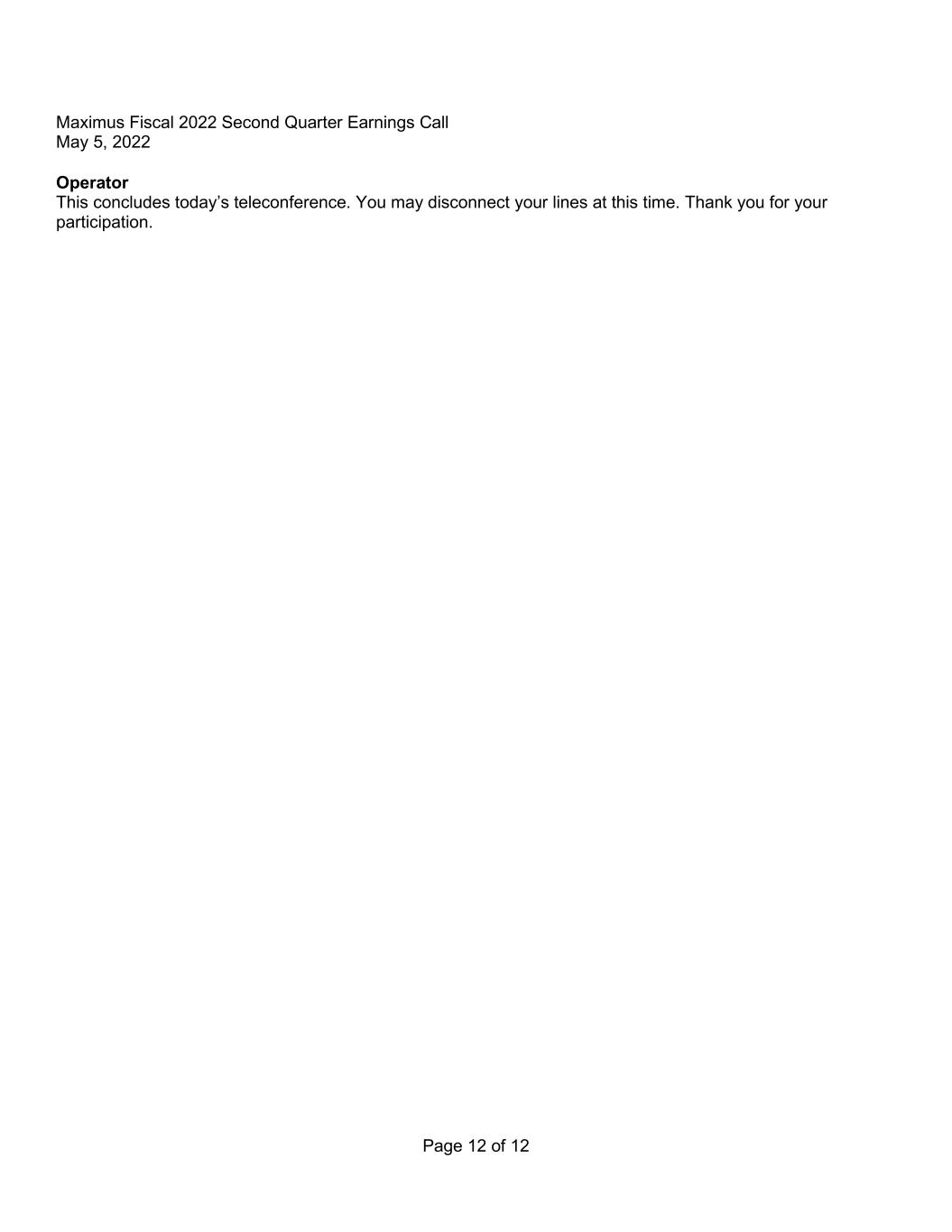
Maximus Fiscal 2022 Second Quarter Earnings Call May 5, 2022 Page 12 of 12 Operator This concludes today’s teleconference. You may disconnect your lines at this time. Thank you for your participation.